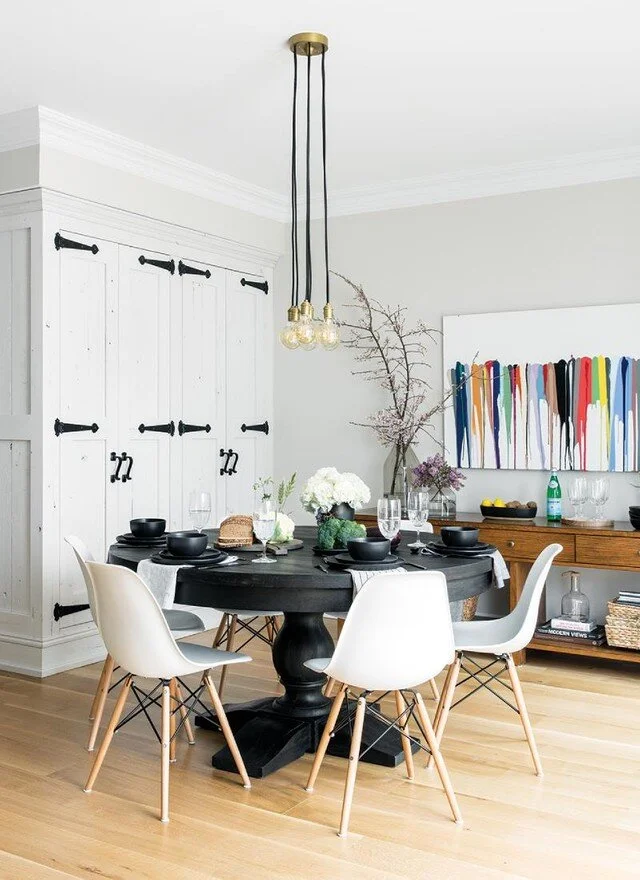What's New in Art, Architecture, and Design
What’s New in Art, Architecture, and Design
Trending: Contemporary Florals, Modern Farmhouses, and “Experiential” Rooms
Floral paintings are making a contemporary comeback, farmhouses are getting modern face-lifts, and rooms are offering design “experiences.” Here are the latest trends in art, architecture, and design.
ART
A new generation of artists is breathing life into a centuries-old subject: florals. The works, which range from traditional botanicals to avant-garde abstractions and edgy photographic images, are intimate portraits of nature in all its glorious phases. Stockholm-based photographer Carl Kleiner often employs flowers in his works, creating undulating images with stems and petals in impossibly whimsical positions. Belfast painter Ted Pim has been creating oil-on-canvas rose bouquets for the past 15 years. The works, which sell for US$3,000 to US$22,000, are brutally brooding and literally dripping with subtle significance.
“Roses are a symbol of love but also can be incredibly dark,” he says. “I grew up listening to Tarot readings my friend’s grandmother did, and I learned that the rose is a symbol of balance. It expresses promise, new beginnings and hope. Its thorns represent defense, physicality, loss, and thoughtlessness. I use these themes in my work to create beautiful pieces of art.”
Inspired by 18th-century works of Dutch painter Rachel Ruysch, Pim deliberately flaws “perfect floral scenes, with every inch analyzed and overanalyzed for imperfections” by dripping a mixture of etching ink and white spirits over the work at the end to emphasize the unpredictability and fragility of life. “It’s a thrill to pour the mixture over the oils, trying to balance the elements of destruction and creation,” he says. “A lot of people would ask if the flowers I paint are dying or coming to life. I like that they have to make up their own minds.”
Belfast-based artist Ted Pim paints striking oil-on-canvas rose bouquets.
ARCHITECTURE
The so-called modern farmhouse is one of the latest manifestations of the quest to create a classical, comfortable residence that is suitable for casual, contemporary life
The hybrid houses, which are, on the outside, spare and Shaker simple, feature opulent, open-plan interiors and are sited to exploit the sun and the natural breezes.
“Modern farmhouses combine traditional forms with the clarity, simplicity, and openness of Mid-Century Modern architecture,” says architect Matthew Griffith, a principal of in situ studio in Raleigh, N.C. “Farmhouses were not meant to be decorative—they were practical, and they were beautiful, quiet places.”
The wood-sided structures, which typically have durable metal roofs, take design cues from vernacular farmhouses, yet look more austerely elegant than agrarian.
A modern farmhouse from North Carolina-based in situ
“The interior spaces are not always one room,” Griffith says, noting that in one in situ studio project, a stairway serves as an architectural connector.
He says that the form, which blends indoor and outdoor spaces, has become so popular that “it’s a movement—developers of spec properties are using the term ‘modern farmhouse’ to describe them. Five years ago, when we designed our first one at a client’s behest, it was a novelty.”
DESIGN
The rooms we live in should not simply be seen but also appeal to the emotions. That’s the credo of experiential design, whose spaces stimulate the five senses.
Becky Shea, whose eponymous design firm is based in New York City and Los Angeles, sees such design as “holistic therapy” that creates “a subconscious calm.”
In her interiors, she evokes memories with, among other cues, materials, meditative ambient sound, living walls, and a signature scent diffused through the HVAC system.
Becky Shea used old flooring that meant something to her clients to create built-ins in a breakfast room.
In one project where her clients were renovating the family home, she used its old flooring to create built-in cabinetry for the breakfast room. “Now, every day, they are reminded of the memories that were created on the floors,” she says.
For another home, she designed an oversize custom rug that matched the material of the client’s favorite sweater. “She told us how much she loves the experience of waking up and wiggling her toes in the plush alpaca boucle before starting her day,” Shea says.
Digging deeply into the client’s psyche is key to the process. “If conventional design is like dating, experiential design is more like being married with two kids and a pet,” she says. “We get to know every detail about our clients from what kind of deodorant they use to where they vacationed as children.” Shea says she knows the design is successful “when clients tell us they’ve never felt more ‘at home.’”




